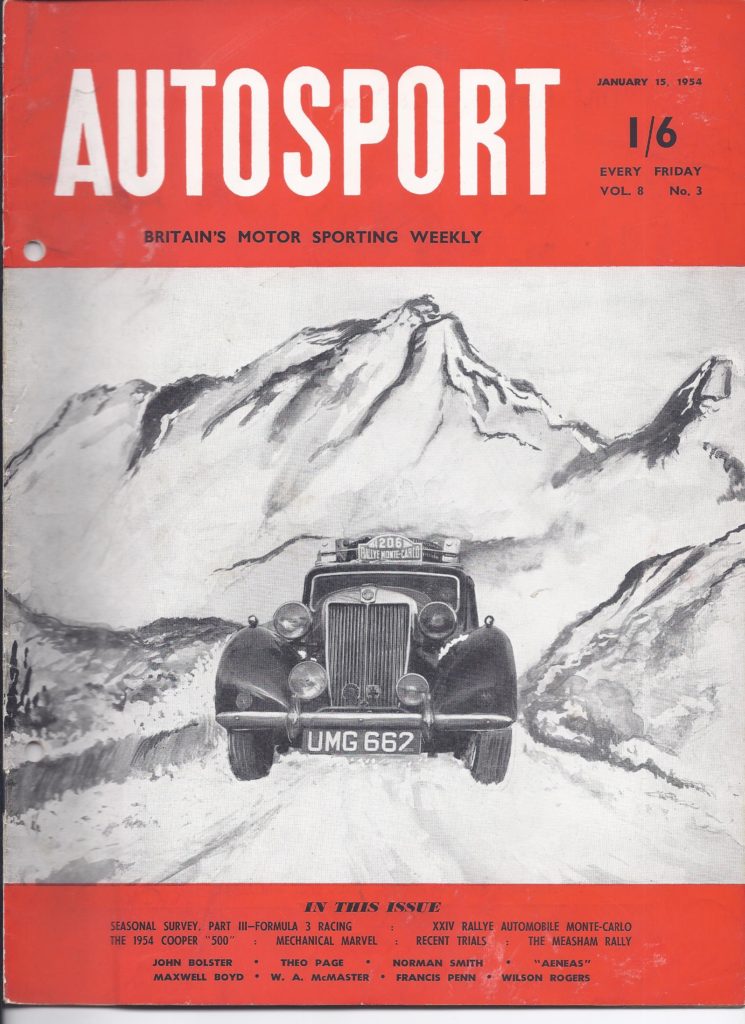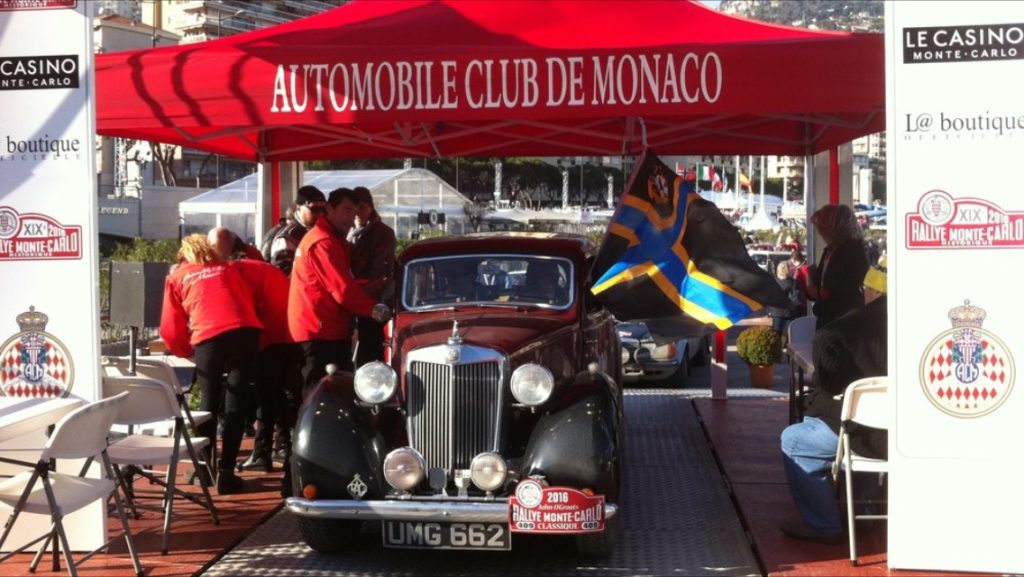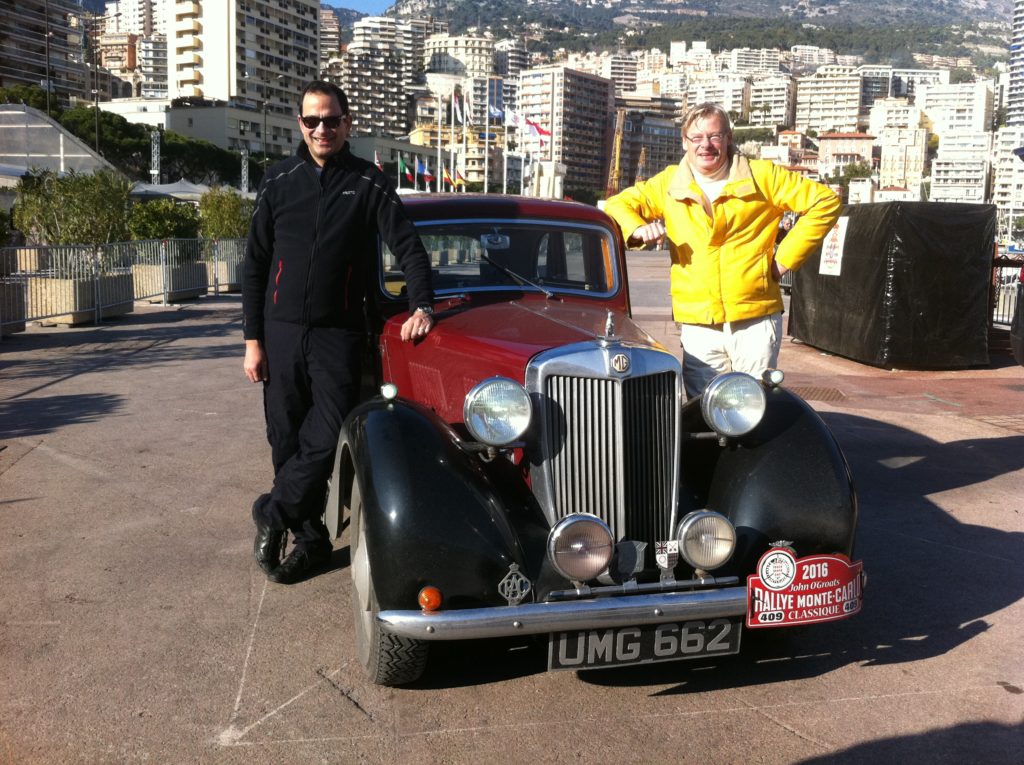Monte Carlo Rally in a YB
By Marc Hanson
Gregor Grant, the founding editor of the Autosport Magazine, owned an MG YB saloon which was his personal transport as well as the office hack. He bought it new from the MG factory and kept it for two years. In that time it was used as a press car for numerous UK and continental events, including the Mille Miglia and the Monte Carlo Rally.

Gregor and his close friend (and sometime MG Works driver) George Phillips also used the car competitively, including on the Scottish Rally in 1953 and the Production Touring Car race at Silverstone in the same year. They also competed in the 1954 Monte Carlo Rally. Whilst they completed the entire rally, they were sadly disqualified for missing the last time check.
I bought Gregor’s old car, UMG 662, last year with the intention of running it on the Monte Carlo Historique Rally. Sadly, I found out that that rally now only caters for newer cars (1955 to 1980). However, I discovered that in January 2016 the Automobile Club de Monaco were running a special one-off Classique Monte Carlo rally celebrating 80 years since the first British winner.

UMG 662 on the cover of Autosport, January 1954 
UMG heading off from the John O’Groats start
They were keen for Gregor’s old car to take part, so I set about frantically getting the car ready. The car was checked over, fitted with LED bulbs for better lighting, and treated to a new set of winter tyres. The car was ready and on Sunday January 24 was trailered up to John O’Groats for the start on Wednesday 27. The planned route was through the Highlands to Paisley, where we were to join the cars doing the Historique rally.
From there we were to go to Dumfries for an overnight stop, before heading to Hull the next day via Croft race circuit. We then planned to take the overnight ferry to Zeebrugge and meet up with the Historique cars again in Rheims on Friday. From there it was intended to be 36 hours non-stop through France, over the Alpes Maritime to Monaco. In total, around 1,600 miles in four days.
Scrutineering took place the afternoon before the start in unusually sunny conditions. The Lord Lieutenant of Caithness made all the crews welcome at a civic reception in John O Groats the evening before the start. By a strange twist of fate, it transpired her uncle, Bertie Sutherland, who competed on the Monte many times in the 50s, had owned UMG 662 in the 70s. The rally took us through Golspie and right past the front door of the garage where the car had sat under restoration for 10 years!

The Y Type and occupants enjoying the Croft Circuit
With the new LED headlights burning brightly, we were flagged off at dawn on Wednesday 27 from John O’Groats by the Lord Lieutenant of Caithness. Despite the bitter cold and early hour, we were grateful that a large number of local people assembled to see us off. We were also given bags with local delicacies including miniature bottles of local whisky and some homemade biscuits. The hospitality of the people of John O’Groats was magnificent.
After a spectacular drive down the coast to Inverness (following the route of the 1926 rally) we headed up towards Aviemore and the Cairngorms. The weather deteriorated and we were hit by a blizzard of sleet and snow. I had taken the precaution of fitting period demisters but neither these nor the wipers could cope. Luckily, this was the worst weather we were to encounter on the whole rally. As is often the case in Scotland, the bad weather cleared as quickly as it arrived.
By the time we made it to Perth the sun was shining. The road from Perth to Glasgow took us past the famous Gleneagles Hotel. I could not resist stopping at the hotel for a photo. In 1953 Gregor Grant driving UMG 662 won his class in the driving tests held at Gleneagles during the Coronation Rally. This was probably the first time the car had been back in 63 years.

UMG 662 heading out from the Paisley Start 
Ready for the start from the Rheims ramp
The traditional start of the Monte in the UK is Glasgow, but in recent years the largest town in Scotland, Paisley, has taken on the mantle. It was at Paisley that we met up with the cars doing the Historique rally to Monte Carlo, as well as 20 or more cars doing local ‘Monte Heritage’ runs from Paisley to Dumfries. The paddock was just by the Old Abbey and Town Hall.
The Provost of Paisley very kindly welcomed us at a civic reception in the town hall, whilst members of the public who had turned up to see the start had the opportunity to inspect the cars and chat to the drivers. The start of each car from the gantry was greeted by fireworks and the cheers of over a thousand spectators. The very warm welcome given to the Rally by the people of Paisley was greatly appreciated. After leaving Paisley we had a short night-time run to Dumfries where we made our first overnight stop. The Historique guys had no such luxury, heading straight down the motorway to a distant Dover.
The next morning, the route from Dumfries took us over the border into Cumbria, and then over the Pennines to Croft Motor Circuit near Darlington. We had the opportunity to do some laps of the circuit and I believe this was the first time that UMG 662 had been on a race circuit since it raced at Silverstone in the 1953 Daily Express Production Touring Car race (3rd in class!).
Some unwelcome news at Croft was that the ferry we were due to take overnight from Hull to Zeebrugge had been cancelled due to bad weather. Alternative arrangements were put in place, but entailed a long slog down the A1 to Folkestone and the Channel Tunnel. Unfortunately, we arrived on the M25 at rush hour with traffic over the Dartford Crossing held up by high winds. We ended up sitting in a traffic jam for over an hour. Much to our relief UMG 662 did not overheat and we managed the crossing to France via the Chunnel without further incident.
After arriving late in the evening at Calais, we were keen to find somewhere to catch a few hours’ sleep before heading off to Rheims early the next morning. Alas, all the hotels near the coast were full and we were lucky to be able to get the last couple of rooms at a motel near Arras. Whilst that meant we did not get much sleep, it did mean the drive to Rheims the next morning was relatively quick.
In Rheims we faced a dilemma – start cracking on south or follow the Historique cars after their start from Rheims that evening? As there was no penalty in starting immediately, we decided to crack on to cover as much of the route south as possible in daylight. The downside was that we left Rheims in front of some rather sparse grandstands.

The drive south from Rheims took us on some fantastic and surprisingly quiet Route Nationale roads. The weather was dry and clear and we made rapid progress. We arrived at the old fortified city of Langres at dusk and met up with a large group of German Historique cars that had arrived shortly before us from Bad Homburg, near Frankfurt. Although the Historique caters for cars built after 1955 and before 1981, the majority of these German cars (Golfs, Opel Kadetts and 911s) illustrated what is needed these days to be competitive on the Historique.
We left Langres just as it got dark. From then on we made great use of our LED headlamps and spotlights as we ran on through the night (and thick fog) past Lyon and Dijon, stopping at all the main time controls. Some were harder to find than others. The one at Bourgoin-Jallieu (reached at 2.00am) was hidden away on a service road on an industrial estate a mile from the town centre!
After a brief rest stop in Grenoble we started climbing up into the Alpes Maritime just as dawn was breaking. Whilst there was snow on the mountains, the roads were clear. This was something of a relief as we had no snow chains. Funnily enough, the weather mirrored that in 1954 when UMG 662 last passed this way. Sunshine and no significant snow! Much to my surprise UMG 662 had no trouble tackling the mountain passes, mostly in third gear but sometimes in second. The bitter cold (it was -5 deg C) certainly helped in preventing overheating.
We arrived at Saint Andres-les-Alpes in the late morning, by which time we had been caught up by the Historique cars. It’s fair to say we caused quite a stir. A camera crew filmed an interview with Per (my co-driver) that is included at length in the official Auto Club de Monaco TV programme on the Historique and Classique Rallies. The rally fans seemed a bit bored with the endless parade of Porsche 911s, Golfs and Opel Kadetts. Anything unusual and/or old attracted lots of attention.

The finish of the 2016 Rallye Monte-Carlo Classique 
A triumphant Y Type at the finish
The route from Saint Andres-les-Alpes to Monaco was relatively straightforward and downhill all the way. Within a few hours, we reached Nice on the coast, where it was sunny and a good 10 degrees warmer than up in the mountains. As we were so close to Monaco we decided to sprint to the finish by taking the péage from Nice to the principality. What we had not recalled was that the 30 or so miles to Monaco from Nice is for the main part uphill.
The strain on the engine pulling the car uphill non-stop for 30 minutes in the warm air caused her to overheat. We pulled over some 10 miles from Monaco and let her cool down a bit. To her credit, this was the only trouble we had on the whole trip. Once we had cooled down a bit, we very gingerly motored on to La Turbie, where we turned off the péage and coasted down several thousand feet to the finish line at Monaco harbour. When we arrived at the finish we found the ACM still setting up. We were the first car to cross the finish ramp of all the Classiques and indeed all the Historiques too! Here we met up again with Claude Plasseraud of the ACM, who had scrutineered and seen us off from John O’ Groats four days previously, and was at the finish to welcome us. The hospitality and efficiency of the ACM was first-rate.
This was the first time that UMG 662 had been classed as a finisher on the Monte, having been a non-competitive press car in 1953 and having been disqualified in 1954 on arrival in Monaco. We parked the car up by the harbour and adjourned for a well-earned celebratory drink at the Café de Paris in Casino Square. A £15 bottle of beer never tasted so good! That evening we attended a reception at the rally hotel – the rather grand Fairmont – before heading off to bed in a degree of comfort we had missed in the previous few days!

The Rallye Monte Carlo Classique proved so popular with spectators and officials that the ACM deemed it a great success. As such, they have announced that in future it will become a regular fixture running in parallel with the established Historique Rally. The Classique will be open to cars of a type that ran in the Monte in period but entrants will not need to have FIVA or FIA papers. There will also be a much larger entry list than this year with 20 cars starting from each of the start cities. It is a great event and I thoroughly recommend it. As there will only be 20 Glasgow starters, you will need to hurry to make sure of your entry.
Marc’s full blog of the Monte Carlo event can be found online at https://morewheelspin.com

 MG Car Club
MG Car Club